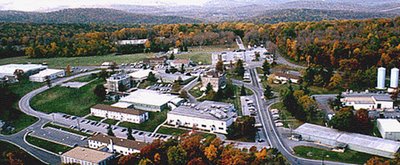Mount Weather Gets a Little Facelift

I can think of no better person than Tom Vanderbilt to offer us a report on the current operations (as seen from as close up as possible) of the Mount Weather Emergency Operations Centre in Virginia’s Facquier County, just 75 miles west of Washington DC.
The complex, guarded by hillsides of forests, barbed wire, no trespassing signs, and roving Ford F-150’s driven by men with sunglasses, is run by the Federal Emergency Management Authority (Fema). But, unofficially, it is understood, Mount Weather “is a massive underground complex originally built to house governmental officials in the event of a full-scale nuclear exchange." Vanderbilt writes for the Guardian, "Today, as the Bush administration wages its war on terror, Mount Weather is believed to house a "shadow government" made up of senior Washington officials on temporary assignment.”

Sprawling across 500 acres, “it functions like a rump principality” he says, “with its own leaders, its own police and fire departments, and its own set of laws.” In an age of satellite omniscience and ubiquitous aerial surveillance, it is somewhat ironic that Mount Weather is apparently more easily viewed from outer space than right up close. In the beautiful Blue Ridge landscape, there is said to be two Mount Weathers: the Fema run facility, and the more clandestine “undisclosed location” that becomes signature of the Bush administration’s convoluted secrecy.
Vanderbilt’s guide Tim Brown is a national security researcher and aerial imagery expert. He points out some of the newer exterior landscape additions to the peripheral armor and shading of the complex: new black sheeting threaded through the border fencing to obscure views of the helipad, truck barriers installed at the entrance to slow vehicles down. “They got smart” he says. Signs of taking necessary security precautions in an era of elevated terrorist attacks, or more furtive gestures of an administration that prefers to conduct its political affairs in deeper enclaves devoid of any outside scrutiny? Either way, the locals agree, the centre’s activity hasn’t been more obvious since the days of Eisenhower.

Vanderbilt gives us a good glimpse of the facility’s - sketchy at best - publicly known history, and explains how a drilling exercise in the ‘50’s led the Army Corps of Engineers to a full on experiment in underground city building. “The base”, he tells us, “formed part of a "federal relocation arc", an archipelago of hardened underground facilities, each linked by a dedicated communications system and equipped with amenities ranging from showers to wash off nuclear fallout to filtration systems capable of sucking air clean down to the micron level. The sites, staffed by "molies", were spartan steel-and-concrete expanses, subterranean seats of power: the president could repair to Mount Weather; Congress had its secret bunker under the Greenbrier Hotel in Virginia; the Federal Reserve had a bunker in Culpepper, Virginia; the Pentagon was given a rocky redoubt called Site R in the mountains of southwestern Pennsylvania; while the nation's air defences were run out of Norad's (North American Aerospace Defence Command) Cheyenne Mountain facility.”

With the undergound bunker 'Raven Rock' in Pennsylvania, CLUI informed us back on 2002, these two facilities "function as the main relocation sites for the highest level civilian and military officials, and what is called, seemingly interchangeably, the "Continuity of Government" and the "Continuity of Operations Plan" (COOP). The present day version of this plan, when it is activated, as recent articles in national newspapers have claimed, calls for 75 to 100 government workers to be kept in one of two underground locations, briefed daily and prepared to take over if the active, elected government is wiped out. COOP was activated hours after the attacks on September 11, and since that time these unknown individuals have been serving in rotations lasting up to three months, in Raven Rock and Mount Weather."
On September 11th 2001, the congress was suspected of being shuttled to Mount Weather. In this new article, Vanderbilt speaks with some intriguing locals living nearby the facility, as well as some ex-government employees willing to share some of the highlights of their fascinating resumes (that is, if you are, say, a military spy novelist), who remark on some of the more curious and absurd historical traces of the facility's use, like, for instance, when the Russians were given by the State Department a tract of land there to use for their own R&R center. But, as open as some were to talk about Mount Weather from their own mysterious vantages, Vanderbilt finds a population of relatively sealed lips. However, the escalating activity, especially immediately following the 9/11 attacks, has some saying that it has only drawn more attention to the facility rather than to help strengthen it as any kind of secret refuge for the government. Nevertheless, no one has ever been inside has ever spilled any beans, and so, as usual, we can only wonder what government programs are ticking away in the subterranean vaults of the nation's capitol emergency operations station.
[See these earlier posts: Through the Turnstile; Touring the Greenbrier; Secret Cities of the A-Bomb; Area 71; Washington's New 'Survival City'; A Silo Full of Cash; Secret Soviet Submarine Base; Fortress Baghdad; The 'Long War' enters its capsule; Subterranean Urbanism; Tokyo Secret City; Bunker Archaeology; Smugglers' Paradise Uprooted; [Re] improvising sub_Base landscapes; Secret Synagogue; Mt. Seemore and the watchful gaze; from Leftover-Bunkers to Tourist-Traps...; A "Closed Atomic City": Open for Business]







0 Comments:
Post a Comment
<< Home